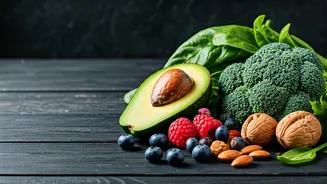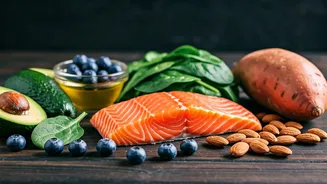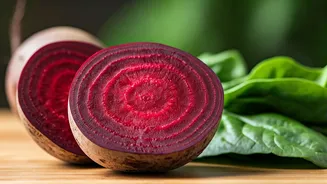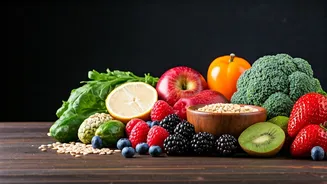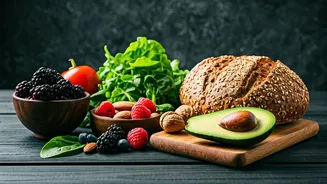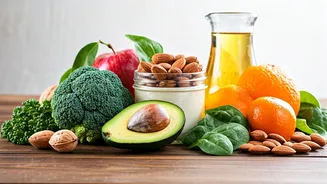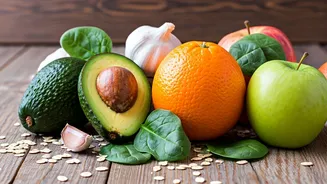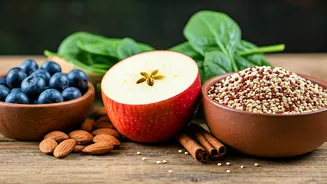Introduction: Blood Sugar
Blood sugar regulation is a key aspect of maintaining a healthy body, and the food choices we make have a significant impact on this process. Consuming
foods that do not lead to drastic spikes or drops in blood sugar levels helps keep the body functioning optimally. Several foods have natural properties that support this regulation. These foods, often readily available and simple to integrate into daily meals, can make a difference in your health. This article explores six such foods and how they can benefit your body. These foods are easily found in local markets, making them accessible to most people. They can be added to your diet and provide a natural approach to improve well-being. By understanding how these foods work, individuals can take charge of their health and make informed food choices to regulate blood sugar levels. This strategy is an important part of a holistic approach to good health.
Focus: Fiber-Rich Foods
Foods high in fiber can significantly aid in blood sugar control, slowing down the absorption of sugar into the bloodstream. This prevents rapid increases in blood glucose levels after eating. Including fiber-rich options in your diet can support more stable energy levels throughout the day and helps in the prevention of diabetes and other health complications. Examples of fiber-rich foods include whole grains such as oats and brown rice, and legumes like lentils and beans. Additionally, many fruits and vegetables, such as apples, berries, and leafy greens, are also rich sources of dietary fiber. Incorporating these foods into your meals can ensure you are consuming enough fiber. Fiber not only helps manage blood sugar but also supports digestive health. A diet rich in fiber contributes to feeling fuller for longer, which can also help manage weight, and reduce the risk of other health issues.
Vegetables: A Crucial Group
Vegetables are vital for blood sugar control, offering low-carb and high-fiber options that contribute to stable blood glucose levels. Non-starchy vegetables such as spinach, kale, broccoli, and cauliflower are particularly beneficial. These vegetables are packed with nutrients and have a minimal impact on blood sugar. Including a variety of vegetables in your daily diet can help provide essential vitamins, minerals, and antioxidants, supporting overall health. Try to incorporate different colors of vegetables. Think about adding a side of cooked vegetables or a fresh salad at lunch or dinner. You can even enjoy vegetables as a snack. Consistent consumption of vegetables is an important part of a healthy diet. This helps improve blood sugar and contributes to a balanced nutritional intake. They are accessible and easy to prepare, making them a practical addition to your meals.
Healthy Fats: Essential Role
Healthy fats are essential for managing blood sugar levels because they slow down the digestion process, leading to a slower release of glucose into the bloodstream. This prevents sharp spikes in blood sugar. Sources of healthy fats include avocados, nuts, seeds, and olive oil. Incorporating these foods into your diet can assist in keeping blood sugar levels steady. Avocados and olive oil can be used in numerous ways in cooking. Nuts and seeds can be easily consumed as snacks. Healthy fats also play a significant role in improving heart health and providing essential nutrients. Healthy fats provide more than just blood sugar benefits. They also support cardiovascular health and reduce inflammation. By choosing healthy fats over saturated and trans fats, you promote overall well-being. The inclusion of healthy fats is thus a multifaceted strategy.
Protein: Building Blocks
Protein-rich foods, like lean meats, fish, eggs, and legumes, support blood sugar control by slowing down the absorption of carbohydrates. This helps prevent rapid increases in blood glucose, offering a gradual release of energy. Including protein with your meals ensures that you feel full longer, which also helps control your food intake throughout the day. Protein is essential for many bodily functions, including muscle repair and growth. Lean meats, such as chicken and fish, can be part of balanced meals. Eggs are versatile and can be used in breakfast, lunch, or dinner. Legumes, such as lentils and beans, also offer a good source of protein, along with fiber. Prioritizing protein is an important part of blood sugar management. By consuming protein-rich foods, individuals can achieve more consistent blood sugar levels and improved energy stability.
Spices: Enhancing Benefits
Certain spices have been shown to have positive effects on blood sugar regulation, offering additional benefits. Cinnamon, for example, has been studied for its ability to improve insulin sensitivity, which helps glucose enter the cells more efficiently. Other spices such as turmeric and ginger also offer anti-inflammatory properties, which can help support overall metabolic health. The inclusion of these spices into your meals is easy. Cinnamon can be sprinkled on oatmeal, added to coffee, or included in baked goods. Turmeric and ginger can be added to curries, stews, or even smoothies. These spices can provide both flavor and health benefits. Integrating these spices can make healthy eating more enjoyable. Using spices that provide positive effects, individuals can enhance their overall blood sugar management and promote better health.
